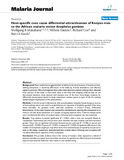| dc.description.abstract | Abstract
Background
Many studies have suggested that variability in the attractiveness of humans to host-seeking mosquitoes is caused by differences in the make-up of body emanations, and olfactory signals in particular. Most investigations have either been laboratory-based, utilising odour obtained from sections of the body, or have been done in the field with sampling methods that do not discriminate between visual, physical and chemical cues of the host. Accordingly, evidence for differential attractiveness based on body emanations remains sparse in spite of the far-reaching epidemiological implications of this phenomenon.
Methods
A new three-port olfactometer that accommodates complete human beings as sources of host-seeking stimuli was used to study behavioural responses of Anopheles gambiae Giles sensu stricto (hereafter An. gambiae) under semi-field conditions in western Kenya. Differential attractiveness of nine male Kenyans was assessed by simultaneously exposing the mosquitoes to (a mixture of) total body emanations of 3 people occupying separate tents. Controls (empty tents) were included and the effect of residual odours following tent occupation was also examined.
Results
Trap catches increased significantly (P < 0.001) when a tent was occupied. Based on 'competition' experiments, the nine persons were classified into least, medium and most attractive groups. There was no significant interaction between person and trap (P = 0.302) or person and test period (P = 0.223). Presence (P < 0.001) or absence (P = 0.949) of significant differences in the number of mosquitoes caught per trap when tents were simultaneously occupied by one person in each or left empty, respectively, demonstrated that residual odours following tent occupation did not affect behavioural responses of the mosquitoes.
Conclusion
We provide evidence that in the vicinity of humans, when exposed to a blend of physical and olfactory signals from more than one host, An. gambiae can effectively and consistently express host-selection behaviour that results in non-random biting. | |


